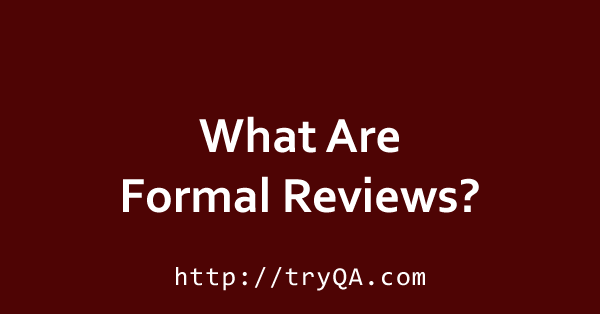What Is the First Phase of an Ofccp Compliance Review Checklist
Formal reviews follow a formal process. It is well structured and regulated.
A formal review procedure consists of vi master steps:
- Planning
- Kick-off
- Preparation
- Review coming together
- Rework
- Follow-upwardly
ane. Planning: The beginning phase of the formal review is the Planning phase. In this phase thereview process begins with a request for review by the author to the moderator (or inspection leader). A moderator has to take care of the scheduling like date, time, place and invitation of the review. For the formal reviews the moderator performs the entry cheque and also defines the formal go out criteria.

-
-
- The documents should not reveal a big number of major defects.
- The documents to exist reviewed should be with line numbers.
- The documents should be cleaned up by running any automated checks that utilise.
- The writer should feel confident about the quality of the document so that he tin can join the review team with that certificate.
-
Once, the certificate clear the entry cheque the moderator and writer decides that which part of the document is to be reviewed. Since the human heed can sympathize only a limited set of pages at one fourth dimension so in a review the maximum size is between 10 and 20 pages. Hence checking the documents improves the moderator ability to atomic number 82 the meeting because it ensures the better understanding.
ii. Kick-off:This kick-off meeting is an optional footstep in a review procedure. The goal of this step is to give a brusque introduction on the objectives of the review and the documents to anybody in the meeting. The relationships betwixt the document under review and the other documents are also explained, especially if the numbers of related documents are high. At customer sites, we take measured results up to 70% more major defects found per page as a result of performing a boot-off, [van Veenendaal and van der Zwan, 2000].
3. Training: In this step the reviewers review the document individually using the related documents, procedures, rules and checklists provided. Each participant while reviewing individually identifies the defects, questions and comments according to their understanding of the document and role. After that all problems are recorded using a logging form. The success factor for a thorough preparation is the number of pages checked per hour. This is called the checking charge per unit. Usually the checking rate is in the range of five to x pages per hour.
four. Review meeting: The review meeting consists of three phases:
- Logging phase: In this phase the issues and the defects that have been identified during the preparation step are logged page by page. The logging is basically done by the writer or by a scribe. Scribe is a separate person to do the logging and is especially useful for the formal review types such equally an inspection. Every defects and it's severity should be logged in whatever of the three severity classes given below:
— Critical:The defects volition cause downstream damage.
— Major: The defects could cause a downstream damage.
— Minor: The defects are highly unlikely to cause the downstream damage.
During the logging phase the moderator focuses on logging as many defects as possible within a certain time frame and tries to keep a good logging rate (number of defects logged per infinitesimal). In formal review coming together the good logging rate should be between one and two defects logged per minute.
- Discussion phase: If any issue needs discussion and so the item is logged and then handled in the word phase. As chairman of the discussion meeting, the moderator takes intendance of the people bug and prevents discussion from getting too personal and calls for a intermission to absurd down the heated discussion. The upshot of the discussions is documented for the future reference.
- Decision phase: At the terminate of the meeting a decision on the document under review has to be made by the participants, sometimes based on formal exit criteria. Exit criteria are the average number of disquisitional and/or major defects found per page (for example no more than three critical/major defects per page). If the number of defects constitute per page is more than a sure level so the document must be reviewed again, afterwards it has been reworked.
5. Rework: In this step if the number of defects found per page exceeds the certain level then the document has to be reworked. Not every defect that is establish leads to rework. It is the author'due south responsibleness to estimate whether the defect has to be fixed. If nothing tin be washed about an issue then at least it should be indicated that the author has considered the issue.
half-dozen. Follow-upward: In this step the moderator bank check to make sure that the author has taken activity on all known defects. If it is decided that all participants will check the updated documents then the moderator takes care of the distribution and collects the feedback. It is the responsibleness of the moderator to ensure that the data is right and stored for future analysis.
Other pop articles:
Reader Interactions
shakespeareextesed.blogspot.com
Source: http://tryqa.com/what-is-formal-review/
0 Response to "What Is the First Phase of an Ofccp Compliance Review Checklist"
Post a Comment